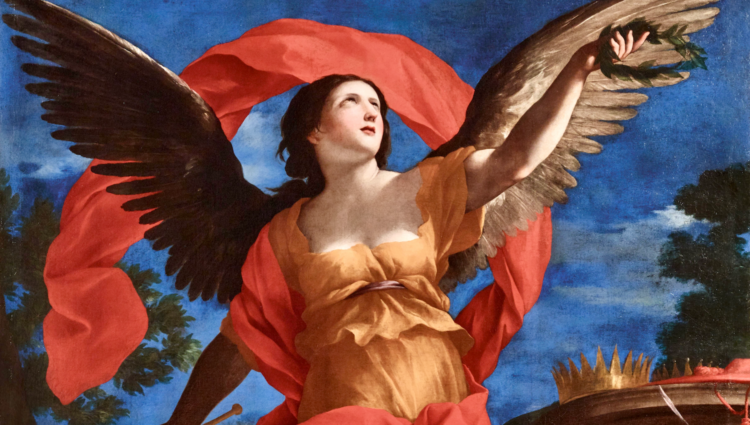The fame of the saints is not only good but should be proclaimed from the hilltops. The fortunes of the rich, if used charitably, are goods that can do a lot of good in alleviating suffering and edifying souls. It is not fame or fortune that is the problem but the prideful pursuit of fame and fortune.
A recent article in the online journal Aleteia (“Cimabue, the genius Italian painter eclipsed by Giotto”) highlighted the whole issue of the fickleness of fame. Such is Giotto’s giant stature that his eclipse of Cimabue from the limelight of history is almost total. Nowhere is this evident more bluntly and graphically than in the title of Michael Levey’s celebrated work on art history: From Giotto to Cézanne: A Concise History of Painting. It seems, in the judgment of Levey and art historians generally, that the history of western art begins with Giotto. Moving from the sublime to the ridiculous, and indulging in the art of the reductio ad absurdum, it might remind us of John Lennon’s words of dubious judgment on the history of rock n roll: “Before Elvis there was nothing.” On the other hand, and ascending once again to the plateau of high culture, it could remind us of the cautionary words on Cimabue and Giotto uttered by the shade of another artist, Oderisi, in Dante’s Purgatorio:
Once, Cimabue thought to hold the field
In painting; Giotto’s all the rage today;
The other’s fame lies in the dust concealed.
This brings us to a contemplation of the connection between fame and fashion. The fame of some seems to endure while others seem to fade as fads and fashions change. Sometimes, and this is one of the tragic dimensions of history, true giants can be subdued by the pigmies of faddishness, much as Gulliver is subdued by the Lilliputians. This has been the fate of John Dryden and Alexander Pope, whose didactic and rational approach to poetry was attacked by the ascendant Romantic Poets, the latter preferring emotional impressions to rational definitions, elevating the heart over the head. The reputations of Dryden and Pope have never recovered. Today, they might be known to literary scholars but their works are seldom read or taught. Ironically, and this is one of the comedic dimensions of history, the Romantics would suffer the same fate when they would later be attacked by the ascendant modernists, the latter preferring hard-nosed novelty to aesthetic sensibilities. The reputation of nineteenth century Romantic giants, such as Tennyson and Longfellow, have never recovered from the modernist assault on their works.
As always, the great corrective to fashion is tradition. It is when the present age keeps its eye on the rearview mirror, surveying the giants of the past and their timeless fruits, that art is reinvigorated and new generations of artistic and literary giants emerge. The new needs the old because innovation needs inspiration, and inspiration comes from the treasure trove of tradition which is our common inheritance. This is true equally of the arts and the sciences. With respect to the latter, it was Isaac Newton who said famously that he had seen further than others because he was standing on the shoulders of giants. The same phrase or aphoristic metaphor had been employed much earlier by two medieval philosophers, William of Conches and Bernard of Chartres, both of whom used the Latin phrase, nani gigantum humeris insidentes (dwarves standing on the shoulders of giants). William of Conches, writing in the twelfth century, was responding to the sixth century Latin grammarian and poet, Priscian, who had claimed that “young men can simply see more sharply” (quanto juniores, tanto perspicaciores). Begging to differ, William of Conches wrote:
The ancients had only the books which they themselves wrote, but we have all their books and moreover all those which have been written from the beginning until our time.… Hence we are like a dwarf perched on the shoulders of a giant. The former sees further than the giant, not because of his own stature, but because of the stature of his bearer.
Bernard of Chartres, according to John of Salisbury, writing in 1159, had also employed the same metaphor: “Bernard of Chartres used to compare us to dwarfs perched on the shoulders of giants. He pointed out that we see more and farther than our predecessors, not because we have keener vision or greater height, but because we are lifted up and borne aloft on their gigantic stature.”
These words of wisdom bear upon the discussion of fame because they show, first and foremost, that those who believe that the young see more clearly than their elders are mere pigmies who refuse to climb on the shoulders of giants. Such people might have their moment of fame or celebrity, especially in an age in which the cult of youth is idolized, but they can have no lasting legacy. This is why C.S. Lewis reminds us that fashions are always coming and going, but mostly going. Fads fade and dedicated followers of fashion become unfashionable very quickly. To be up to date today is to be out of date tomorrow. This is why the momentary and passing fame of the pigmy is purely pyrotechnic. It’s an explosion which dazzles but dissolves, a mere flash in the pan.
If, however, the pigmy is prepared to stand on the shoulders of giants, respecting tradition and being inspired by it, he can have the inspiration and aspiration to do great things that will bring him lasting fame; and, more important than mere fame, he will be contributing something valuable to the treasure trove of cultural tradition. This is why great artists and great movements in art are always looking backwards. Take, for instance, the various manifestations of nineteenth century neo-medievalism that were part of the Romantic reaction to the cold-hearted rationalism of the preposterously self-named “Age of Reason”. The gothic revival revitalized architecture, the Oxford Movement revitalized religious belief and practice, and the Pre-Raphaelites revitalized the visual arts with the vibrancy of medieval and early Renaissance art, pre-Raphael.
And this brings us back to Cimabue. He is mentioned by the penitential shade of Oderisi as a warning to Dante of the dangers of desiring or pursuing fame. After Dante recognizes Oderisi’s face, honouring him as the “honour of Gubbio and the art they call illuminating”, the once famous artist responds modestly that his reputation has already been eclipsed by Franco Bolognese (whose own posthumous claim to fame rests solely on this solitary reference by Dante). Oderisi then repents of the desire for fame which had consumed his life in ambition:
I should have been less generous, I’ll engage,
While yet I lived, and ardour to outshine
Burned in my bosom with a kind of rage.
It is surely noteworthy that Oderisi’s shade, seeing more clearly after death in the light of God’s justice and mercy, should see worldly ambition as a kind of burning rage:
For pride like that here we must pay the fine;
Nor yet should I be here, but that contrition
Turned me to God while power to sin was mine.
It is equally noteworthy that those repentant sinners who pursued fame should find themselves in the lowest cornice of purgatory reserved for those guilty of the sin of pride. By extension, this means that unrepentant pursuers of fame would find themselves with the prideful souls in the lowest circles of hell closest to the insatiable viciousness of Satan.
Immediately after this expression of contrition, Oderisi launches into one of the most famous orations in the whole of the Divine Comedy warning against the “empty glory of man’s frail ambition” in which the reference to Cimabue and Giotto is made. Earthly fame is likened to “a breath of wind” blown this way and that by the folly of fickle fashion. It will not last the test of time which, in relation to eternity, is briefer than a single wink of the eye:
All your renown is like the hue of grass,
Which comes and goes; who caused it first to start
Green from the ground, he makes it fade and pass.
“True words,” Dante responds as Oderisi concludes, “that rightly teach my heart meekness, and prick my blown-up self-esteem.” Since, on the moral allegorical level, Dante serves, as a character within the poem, as an Everyman figure, representing the reader as much as himself, we are called to heed Oderisi’s words and to learn the lesson taught, taking it to heart and keeping it in mind.
Having connected fame and fashion, and fame and pride, we will conclude by connecting fame and fortune.
Earthly fame and earthly fortune are not evil in themselves; on the contrary, they can be good. The fame of the saints is not only good but should be proclaimed from the hilltops because the saints were not seeking celebrity but sanctity. The fortunes of the rich, if used charitably, are goods that can do a lot of good in alleviating suffering and edifying souls. It is not fame or fortune that is the problem but the prideful pursuit of fame and fortune. It is for this reason that it might be easier for a camel to pass through the eye of a needle than for a famous man to enter the kingdom of heaven.
The Imaginative Conservative applies the principle of appreciation to the discussion of culture and politics—we approach dialogue with magnanimity rather than with mere civility. Will you help us remain a refreshing oasis in the increasingly contentious arena of modern discourse? Please consider donating now.
The featured image is “Allegory of Fame” (17th century) by Giovanni Francesco Romanelli, and is in the public domain, courtesy of Wikimedia Commons.










